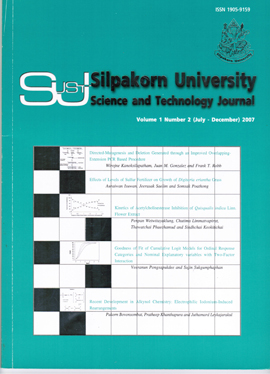Directed-Mutagenesis and Deletion Generated through an Improved Overlapping-Extension PCR Based Procedure
Main Article Content
Abstract
Generating either single or multiple point mutations and producing deletions and insertions into targetDNA sequences are critical and widely used experimental procedures in molecular biological studies. This articlepresents a modified mutagenesis protocol based on an overlapping-extension PCR amplification method. Theprocedure benefits from the design of mutagenic primers to generate overlapping megaprimers without the needfor intermediate purification to remove unused primers. Unused primers are diluted out during the successiveamplification-extension reactions. A key success to this modified method is the use of two flanking primers afterthe overlapping extension reaction. The use of Pfu DNA polymerase increases, compared with Taq DNApolymerase, amplification accuracy. The proposed procedure represents a simple and efficient method thatintroduces many types of mutations into specific target DNA fragments and creates either hybrid DNA fragmentsor internal nucleotide deletions.
Downloads
Article Details
References
Bi, W., and Stambrook, P. J. (1998). Detection of known mutation by proof-reading PCR. Nucleic Acids Research, 26: 3073-3075.
Brons-Poulsen, J., Nohr, J., and Larsen, L. K. (2002). Megaprimer method for polymerase chain reaction-mediated generation of specific mutations in DNA. Methods in Molecular Biology 182: 71-76.
Farabaugh, P. J. and Bjork, G. R. (1999). How translational accuracy influences reading frame maintenance. The EMBO Journal, 18: 1427-1434.
Ge, L. and Rudolph, P. (1997). Simultaneous introduction of multiple mutations using overlap extension PCR. Biotechniques, 22: 28-30.
Kammann, M., Laufs, J., Schell, J., and Gronenborn, B. (1989). Rapid insertional mutagenesis of DNA by polymerase chain reaction (PCR). Nucleic Acids Research, 17: 5404.
Kanoksilapatham, W., Gonz¬lez, J. M., Maeder, D. L., DiRuggiero, J., and Robb F. T. (2004). A proposal to rename the hyperthermophile Pyrococcus woesei as Pyrococcus furiosus, sub sp. woesei. Archaea, 1:277-283.
Laksanalamai, P., Jiemjit, A., Bu, Z., Maeder, D. L., and Robb, F. T. (2003). Multi-subunit assembly of the Pyrococcus furiosus small heat shock protein is essential for cellular protection at high temperature. Extremophiles, 7:79-83.
Lai, R., Bekessy, A., Chen, C. C., Walsh, T., and Barnard, R. (2003). Megaprimer mutagenesis using very long primers. Biotechniques, 34: 52-56.
Nabavi, S. and Nazar, R. N. (2005). Simplifiedone-tube “megaprimer” polymerase chain reaction mutagenesis. Analytical Biochemistry, 345: 346-348.
Tyagi, R., Lai, R., and Duggleby, R. G. (2004). A new approach to ‘megaprimer’ polymerase chain reaction mutagenesis without an intermediate gel purification step. BMC Biotechnology, 4: 2
Wei, D., Li, M., Zhang, X., and Xing, L. (2004). An improvement of the site-directed mutagenesis method by combination of megaprimer, one-side PCR and DpnI treatment. Analytical Biochemistry, 331: 401-403.
Wu, W., Jia, Z., Liu, P., Xie, Z., and Wei, Q. (2005). A novel PCR strategy for high-efficiency, automated site-directed mutagenesis. Nucleic Acids Research, 33: e110.
Wunschel, D. S., Masselon, C., Feng, B., and Smith, R. D. (2004). Proofreading activity of Pfu thermostable DNA polymerase on a 6-O-methylguanine-containing template monitored by ESI-FTICR mass spectrometry. Chembiochem, 5: 1012-1015.


